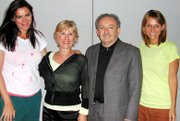Tee Party: C&C Designers Drop In at FBI
For more than a year, C&C California designers Claire Stansfield and Cheyann Benedict have enticed buyers and consumers with ultra-soft and colorful basic T-shirts designed to be layered on the body.
Stansfield and Benedict drew a wide-ranging customer base after the apparel line was featured on the “Oprah Winfrey Show” last year. The brand got a further boost from a national television ad for Visa, which portrayed the designers and their growing company. Today, C&C California ships about $2 million in orders per month to specialty retailers including Ron Herman, Dari and Planet Blue in the Los Angeles area and Scoop in New York.
Both designers agree the key to their success is the use of innovative fabric—not to mention keeping a positive attitude and insisting on advance payment via credit card machines. They say the line works well in a wide range of sizes, from Benedict’s petite size small to the large size meant to fit Stansfield’s 6-foot-plus build.
Henry Cherner, principal of software company AIMS and an advisory board member of Fashion Business Inc., enlisted Stansfield and Benedict to share their meteoric apparel industry rise at the trade organization’s second “Distinguished Speakers Series” presentation, held May 17 at the fashion theater of the California Market Center in Los Angeles. California Apparel News Manufacturing Editor Claudia Figueroa attended the event, moderated by FBI President and Executive Director Frances Harder.
Harder: When you started out, was it because you wanted to be entrepreneurs?
Stansfield: Cheyann and I were at a perfect time in our lives. We really wanted to have our own companyhellip;Cheyann and I don’t have a fashion background, but we were such T-shirt junkies and coveted certain types of T-shirts. We have a vast collection of vintage T-shirts.
When we started out in the business, pants were getting lower, so there was midriff. We’re getting older, and we don’t need our thongs to be showing out the back or our bellies to be out. So we were just coveting the chic T-shirt. So I think business-wise, we were very sure about what we were doing, and we weren’t afraid to go and sell it.
Harder: Did you get a loan?
Benedict: I set up a credit card machine in my house, so we knew that the cash was in our bank account and that we could continue. And then Claire had a little straw basket filled with T-shirts that she would just peddle around to a lot of really great women in Los Angeles. We just wanted to get them out to as many people as possible. We felt that once people got them on their body that they would really love them and want more.
Stansfield: It helped that we had a simple idea. We had six T-shirts, one fabric, no trims, no zippers, no belts, no sequins—it was a basic thing. We really kept our costs down; that way we were able to make a few hundred T-shirts.
Harder: Where are you selling internationally?
Stansfield: We’re in Paris at a great shop called Colette. It’s like a Ron Herman in that it dictates to the rest, especially the department stores and some of the other shops. If Colette buys you, it’s sort of like a stamp of approval. We were very lucky because a very good family friend knows that world—she speaks two languages, she’s an international saleswoman, and [she understood our product]. She got us into Harvey Nichols and Selfridges & Co. and some of the great shops in London, and then in Paris, and then in Milan. Like in Los Angeles and in New York, we started with the buyers from the best boutiques. We just signed a Japanese distributor, we have a Chinese distributor, and we have a Korean distributor.
Harder: Is everything produced domestically here in Los Angeles?
Benedict: The fabric is knitted here, dyed and finished. Everything is done in Los Angeles. I lived in New York for 9 1/2 years, and there’s no way we would ever have been able to accomplish what we accomplished here in New York––it’s just too difficult. Everything we need is here; manufacturing here is so accessible.
Harder: How did you get the Visa commercial?
Stansfield: Visa had already storyboarded it. So we actually got lucky that we already fit the bill. They already decided to do a commercial with two women with their name on a label of a fashion company. They couldn’t find anyone. So then randomly my sister went to college with somebody from the commercial agency, and she said: “Visa’s frantic to find a company with two women’s names on the label. Doesn’t your sister have a T-shirt line and a partner?” So it really was just meant to be. They had already cast and already storyboarded it; they just sort of inserted our company. So it really wasn’t so much about Cheyann and I—it was about Visa, small business and that storyline being the third partner, only they don’t get their name on the label.
Harder: Did that commercial generate a lot of business?
Stansfield: It made us appear like we were more established than we were at the time. We were shipping out of our garages. And then you see this commercial, and it shows all of these people working for the company. Meanwhile, we were in our PJs schlepping boxes ourselves.






















